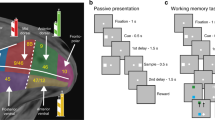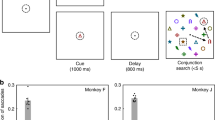Abstract
Rats with medial prefrontal cortex or sham lesions were trained on a visual discrimination task designed for the eight-arm radial maze. After reaching asymptotic performance on this task, both groups were divided into sub-groups that would experience reversal learning in the same or different context from original training. The results showed that both groups reversed in the different context had accelerated learning compared to the groups reversed in the same context. Reversal learning in rats with medial prefrontal cortex damage was faster than sham animals in the same context. These and other results from a transfer test suggest that the medial prefrontal cortex participates in the behavioral effects of a context-specific inhibitory association acquired during visual discrimination learning.







Similar content being viewed by others
References
Ashe J, Lungu OV, Basford AT, Lu X (2006) Cortical control of motor sequences. Curr Opin Neurobiol 16:213–221
Birell JM, Brown VJ (2000) Medial frontal cortex mediates perceptual attentional set shifting in the rat. J Neurosci 20:4320–4324
Blum S, Hebert AE, Dash PK (2006) A role for the prefrontal cortex in recall of recent and remote memories. Neuroreport 17:341–344
Bouton M, Brooks DC (1993) Time and context effects on performance in a pavlovian discrimination reversal. J Exp Psychol Anim Behav Process 19:165–179
Castelo JM, Sherman SJ, Courtney MG, Melrose RJ, Stern CE (2006) Altered hippocampal-prefrontal activation in HIV patients during episodic memory encoding. Neurology 66:1688–1695
Chudasama Y, Robbins TW (2003) Dissociable contributions of the orbitofrontal and infralimbic cortex to pavlovian autoshaping and discrimination reversal learning: further evidence for the functional heterogeneity of the rodent frontal cortex. J Neurosci 23:8771–8780
De Bruin JPC, Swinkels WAM, de Brabander JM (1997) Response learning of rats in a Morris water maze: involvement of the medial prefrontal cortex. Behav Brain Res 85:47–55
Delatour B, Gisquet-Verrier P (1999) Lesions of the prelimbic-infralimbic cortices in rats do not disrupt response selection processes but induce delay-dependent deficits: evidence for a role in working memory? Behav Neurosci 113:941–955
Dias R, Robbins TW, Roberts AC (1996) Dissociation in prefrontal cortex of affective and attentional shifts. Nature 380:69–72
Divac I (1968) Functions of the caudate nucleus. Acta Biol Exp (Warsaw) 28:107–120
Gemmell C, O’Mara SM (1999) Medial prefrontal cortex lesions cause deficits in a variable-goal location task but not in object exploration. Behav Neurosci 113:465–474
Granon S, Poucet B (2000) Involvement of the rat prefrontal cortex in cognitive functions: a central role for the prelimbic area. Psychobiology 28:229–237
Honey RC, Good M (1993) Selective hippocampal lesions abolish the contextual specificity of latent inhibition and conditioning. Behav Neurosci 107:23–33
Holt W, Maren S (1999) Muscimol inactivation of the dorsal hippocampus impairs contextual retrieval of fear memory. J Neurosci 19:9054–9062
Joel D, Weiner I, Feldon J (1997) Electrolytic lesions of the medial prefrontal cortex in rats disrupt performance on an analog of the Wisconsin Card Sorting Test, but do not disrupt latent inhibition: implications for animal models of schizophrenia. Behav Brain Res 85:187–201
Kapp BS, Gallagher M, Holmquist BK, Theall CL (1979) Amygdala central nucleus lesions: effect on heart rate conditioning in the rabbit. Physiol Behav 23:1109–1117
Killcross S, Coutureau E (2003) Coordination of actions and habits in the medial prefrontal cortex in rats. Cereb Cortex 13:400–408
King JA, Hartley T, Spiers HJ, Maguire EA, Burgess N (2005) Anterior prefrontal involvement in episodic retrieval reflects contextual interference. Neuroimage 28:256–267
Kolb B (1984) Functions of the prefrontal cortex in the rat: a comparative review. Brain Res Rev 8:65–98
Kolb B, Burhman K, McDonald RJ, Sutherland RJ (1994) Dissociation of the medial prefrontal, posterior parietal and posterior temporal cortex for spatial navigation and recognition memory in the rat. Cereb Cortex 6:664–680
Lacroix L, Broersen LM, Weiner I, Feldon J (1998) The effects of excitotoxic lesion of the medial prefrontal cortex on latent inhibition, prepulse inhibition, food hoarding, elevated plus maze, active avoidance and locomotor activity in the rat. Neuroscience 82:431–442
Liston C, Miller MM, Goldwater DS, Radley JJ, Roceher AB, Hof PR, Morrison JH, McEwen BS (2006) Stress-induced alterations in prefrontal cortical dendritic morphology predict selective impairments in perceptual attentional set-shifting. J Neurosci 26:7870–7874
Marshuetz C, Smith EE (2006) Working memory for order information: multiple cognitive and neural mechanisms. Neuroscience 139:195–200
McDonald RJ, Hong NS, Devan BD (2004) The challenges of understanding mammalian cognition and memory-based behaviours: an interacting learning and memory systems approach. Neurosci Biobehav Rev 28 (7):719–746
McDonald RJ, King AL, Hong NS (2001) Context-specific interference on reversal learning of a stimulus-response habit. Behav Brain Res 121:149–165
McDonald RJ, Ko C, Hong NS (2002) Attenuation of context-specific inhibition on reversal learning of a stimulus-response task in rats with neurotoxic hippocampal damage. Behav Brain Res 136:113–126
McDonald RJ, White NM (1993) A triple dissociation of memory systems: Hippocampus, amygdala, and dorsal striatum. Behav Neurosci 107:3–22
Mimura M, Yano M (2006) Memory impairment and awareness of memory deficits in early-stage Alzheimer’s disease. Rev Neurosci 17:253–266
Moscovitch M (1992) Memory and working-with-memory: a component process model based on modules and central systems. J Cognit Neurosci 4:258–267
Mumby DG, Pinel JPJ (1994) Rhinal cortex lesions and object recognition in rats. Behav Neurosci 108:11–18
Narayanan NS, Horst NK, Laubach M (2006) Reversible inactivations of rat medial prefrontal cortex impair the ability to wait for a stimulus. Neuroscience 139:865–876
O’Keefe JA, Nadel L, Keightley S, Kill D (1975) Fornix lesions selectively abolish place learning in the rat. Exp Neurol 48:152–166
Packard MG, Hirsh R, White NM (1989) Differential effects of fornix and caudate nucleus lesions on two radial maze tasks: evidence for multiple memory systems. J Neurosci 9:1465–1472
Paxinos G, Watson C (1998) The rat brain atlas in stereotaxic coordinates, 4th edn. Academic Press, San Diego, CA
Powell DA, Ginsberg JP (2005) Single unit activity in the medial prefrontal cortex during Pavlovian heart rate conditioning: effects of peripheral autonomic blockade. Neurobiol Learn Mem 84:200–213
Quirk GJ, Garcia R, Gonzalez-Lima F (2006) Prefrontal mechanisms in extinction of conditioned fear. Biol Psychiatry 60:337–343
Ragozzino ME, Detrick S, Kesner RP (1999a) Involvement of the pre-limbic-infralimbic areas of the rodent prefrontal cortex in behavioral flexibility for place and response learning. J Neurosci 19:4585–4594
Ragozzino ME, Wilcox C, Raso M, Kesner RP (1999b) Involvement of rodent prefrontal cortex subregions in strategy switching. Behav Neurosci 113:32–41
Ranganath C (2006) Working memory for visual objects: complementary roles of inferior temporal, medial temporal, and prefrontal cortex. Neuroscience 139:277–289
Reep R (1984) Relationship between prefrontal and limbic cortex: a comparative anatomical review. Brain Behav Evol 25:1–80
Sage JR, Knowlton BJ (2000) Effects of US devaluation on win-stay and win-shift radial maze performance in rats. Behav Neurosci 114:295–306
Schwartzbaum JS, Poulos DA (1965) Discrimination behavior after amygdalectomy in monkeys: learning set and discrimination reversals. J Comp Physiol Psychol 320–328
Simons JS, Owen AM, Fletcher PC, Burgess PW (2005) Anterior prefrontal cortex and the recollection of contextual information. Neuropsychologia 43:1774–1783
Sutherland RJ, Kolb B, Whishaw IQ (1982) Definitive disruption by hippocampal and medial frontal cortical damage in the rat. Neurosci Lett 31:271–276
Thompson RF (1990) Neural mechanisms of classical conditioning in mammals. Philosophical Transactions of the Royal Society of London. B: Biol Sci 329:161–170
Thomas DR, McKelvie AR, Ranney M, Moye TB (1981) Interference in pigeons’ long-term memory viewed as a retrieval problem. Anim Learn Behav 9:581–586
White NM, McDonald RJ (2002) Multiple parallel memory systems in the brain of the rat. Neurobiol Learn Mem 77:125–184
Wise SP, Murray EA, Gerfen CR (1996) The frontal cortex-basal ganglia system in primates. Crit Rev Neurobiol 10:317–356
Acknowledgments
Dr. Robert McDonald is currently a Canada Research Chair. This research was supported by grants awarded to RJM from the Canadian Stroke Network and the Natural Sciences and Engineering Research Council. We would like to thank Dr. Bryan Kolb for sharing his expertise on the anatomy of the rat prefrontal cortex.
Author information
Authors and Affiliations
Corresponding author
Rights and permissions
About this article
Cite this article
McDonald, R.J., Foong, N., Ray, C. et al. The role of medial prefrontal cortex in context-specific inhibition during reversal learning of a visual discrimination. Exp Brain Res 177, 509–519 (2007). https://doi.org/10.1007/s00221-006-0699-9
Received:
Accepted:
Published:
Issue Date:
DOI: https://doi.org/10.1007/s00221-006-0699-9




